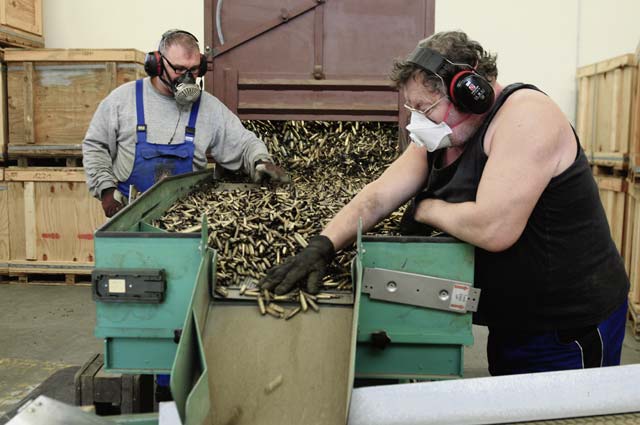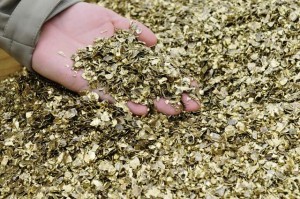
The Theater Logistics Support Center’s U.S. Army Ammunition Center Europe, working with NATO and several other agencies, completed the first sale of demilitarized small arms ammunition residue, consisting primarily of spent small arms cartridges, in a program that is expected to recoup $5 million or $6 million over the first few years and roughly $500,000 each year thereafter.
This sale, consisting of roughly 254 tons of shredded brass from spent bullet casings, marks the first big step in a cooperative effort between ACE, U.S. Army Europe, U.S. Army’s Product Manager — Demilitarization, and NATO Support and Procurement Agency.

Under this program, ACE receives a variety of small arms ammunition casings not deemed as safe, made mostly of brass but also consisting of some steel and other metals. ACE visually inspects all material for live rounds and then shreds the casings to produce what is called “material deemed as safe.” The result is shredded metal that is no longer considered a hazardous material and can be sold to interested parties on the European market. The small chips of brass look a little like gold, and while not as valuable, they are traded internationally as a commodity, much like gold or silver.
More importantly, according to James Lane, 21st TSC’s theater demilitarization manager, disposing of the brass in this manner helps to ensure environmental safety.
“We have to dispose of the ammunition somehow,” Lane said. “This way, we’re making sure that we don’t have live rounds ending up in a land fill or, worse yet, in someone’s back yard.”
The proper disposal of ammunition residue is carefully and stringently controlled by federal and international regulatory agencies, according to Hugh Murray, U.S. Army Europe senior ammunition manager, who also explained that other options for disposing of the ammunition can be much more labor intensive and do not recoup money like this project does.
“There are other ways to dispose of the brass, but the restrictions make it nearly impossible to certify the large stockpiles that have accumulated,” Murray said. “With this, we’re able to receive shipments that may even contain live rounds and render them safe.”
One of the biggest challenges to other methods is the need to completely remove all live rounds from the brass and to perfectly sort the brass by caliber and ammunition type. The turn-in of brass through more traditional channels requires a zero-error process for sorting ammo and removing live rounds, which often requires an impossibly labor-intensive operation.
“You could have a whole battalion of Soldiers at the range for hours sorting through shipments round by round, and you might still end up with live rounds or mixed ammunition,” said Hans-Juergen Becker, ACE deputy director. “A commander doesn’t have time to do that. He’s got a mission to accomplish, so we simply take the brass from him and figure it out ourselves.”
To accommodate a more efficient process for those line-unit commanders to turn in their ammunition residue, ACE accepted much of it in relatively unsorted condition. This left ACE with a stockpile of brass that couldn’t be turned in through traditional methods.
Then ACE, in conjunction with USAREUR, reached out to Product Manager — Demilitarization. PM-D provides oversight of the demilitarization and disposal of ammunition and provides for funding, equipment and other resources to accomplish this function. Working with the PM-D, ACE makes the demilitarized ammunition available to various markets as 30/70 brass, and the money recouped goes back to the U.S. government under the demilitarization Resource, Recovery, and Recycling reinvestment program in accordance with federal law.
Of the funds recouped in these sales, 60 percent of all funds are retained by PM-D for re-use in other demilitarization efforts throughout the Army, and up to 40 percent of the funds can be returned to ACE to further fund the ongoing R3 demilitarization projects there. Funds can be used for equipment, maintenance and even to pay salaries for workers to execute the R3 demilitarization missions.
Of course, to sell the demilitarized brass and recoup any of these funds, ACE had to find a buyer. That’s where NATO came in. Under existing cooperative agreements, NATO Support and Procurement Agency handled the international bidding process and found buyers for the brass. The process of finding a buyer and executing the sale is heavily regulated to prevent fraud waste and abuse, and it’s a process that requires significant expertise. The NSPA’s help in navigating this process can’t be overstated, according to Murray, who as USAREUR’s senior ammunition manager is the central point of contact between the USAREUR and NSPA on this project.
“It’s amazing what NSPA does for us,” Murray said. “Essentially, they find a buyer, execute the transaction and send the check directly to PM-D, and we’re really glad they’re helping us with that part of this process.”


